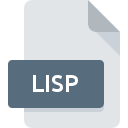.LISP File Extension

Lisp Source Code File
| Developer | N/A |
| Popularity | |
| Category | Developer Files |
| Format | .LISP |
| Cross Platform | Update Soon |
What is an LISP file?
In the vast world of programming languages, Lisp stands out for its unique syntax and powerful features. One of the common file extensions associated with Lisp programming is “.LISP”.
These files primarily contain source code written in Lisp, a family of computer programming languages known for their distinctive parenthesized syntax and expressive nature.
More Information.
Originally, Lisp source code was stored in plain text files with the ‘.LSP’ extension, which stands for “Lisp Source Program.” Over time, ‘.LSP’ evolved into ‘.LISP’, reflecting the evolution of the Lisp language itself.
Lisp source code files served as the primary means of storing and sharing Lisp programs, ranging from simple scripts to complex applications.
Origin Of This File.
The ‘.LISP’ file extension traces its origins back to the birth of Lisp itself. Lisp, short for “LISt Processing,” was developed by John McCarthy in the late 1950s at the Massachusetts Institute of Technology (MIT).
McCarthy envisioned a language that embodied the principles of functional programming and symbolic computation. Lisp quickly gained traction in academia and later in the industry due to its expressive syntax and powerful features.
File Structure Technical Specification.
‘.LISP’ file typically consists of text-based code written in Lisp syntax. Lisp, known for its minimalist yet powerful syntax, employs parentheses to denote both data structures and function calls.
Thus, ‘.LISP’ files contain a series of expressions, each enclosed within parentheses, representing functions, variables, and control structures.
The technical specifications of a ‘.LISP’ file are straightforward. It is encoded in plain text format, making it human-readable and editable using a simple text editor.
The content of a ‘.LISP’ file adheres to the syntax rules of the Lisp programming language, ensuring compatibility with Lisp interpreters and compilers.
How to Convert the File?
Converting a ‘.LISP’ file to other formats or vice versa is a straightforward process, primarily due to its plain text nature. Here are common conversion methods:
- To Executable: Lisp source code can be compiled into executable binaries using Lisp compilers such as SBCL (Steel Bank Common Lisp) or CLISP (Common Lisp). These compilers translate Lisp source code into machine-readable format, generating standalone executables compatible with various operating systems.
- To Other Languages: Lisp code can be translated into other programming languages using automated tools or manual rewriting. While this process may require adjustments to accommodate differences in syntax and semantics, it enables integration with systems that do not support Lisp directly.
- To Library or Module: Lisp code can be packaged as libraries or modules for reuse in other Lisp projects or languages that support foreign function interfaces. Packaging Lisp code in this manner enhances code organization, modularity, and reusability.
Advantages And Disadvantages.
Advantages:
- Expressiveness: Lisp’s syntax allows for concise and expressive code, making it ideal for rapid prototyping and experimentation.
- Flexibility: Lisp’s homoiconicity and dynamic nature enable powerful metaprogramming capabilities, facilitating code manipulation and transformation.
- Interoperability: Lisp integrates seamlessly with other programming languages and systems, enabling interoperability and code reuse.
- Robustness: Lisp’s functional programming paradigm and dynamic typing contribute to robust and resilient codebases, capable of handling diverse use cases.
Disadvantages:
- Learning Curve: Lisp’s unique syntax and paradigm may present a steep learning curve for newcomers, requiring time and effort to master.
- Performance: While Lisp excels in certain domains, such as symbolic computation and artificial intelligence, it may not be as performant as other languages for certain tasks.
- Tooling: Compared to mainstream languages, Lisp may have fewer libraries, tools, and frameworks available, potentially limiting its ecosystem and support.
How to Open LISP?
Open In Windows
- Double-click on the ‘.LISP’ file, and it will open in the default text editor, such as Notepad or Visual Studio Code. Alternatively, right-click on the file, select “Open With,” and choose the desired text editor from the list.
Open In Linux
- On Linux systems, opening a ‘.LISP’ file follows the same process as Windows and MacOS. Double-clicking or using the terminal to open the file with a text editor of choice provides access to the Lisp source code.
Open In MAC
- Similar to Windows, double-clicking on the ‘.LISP’ file will open it in the default text editor, such as TextEdit or Visual Studio Code. Alternatively, right-click on the file, select “Open With,” and choose the desired text editor.













